Mumbai blasts: 1993
(→See also) |
|||
| (2 intermediate revisions by one user not shown) | |||
| Line 1: | Line 1: | ||
| − | |||
| − | |||
| − | |||
| − | |||
{| Class="wikitable" | {| Class="wikitable" | ||
|- | |- | ||
| Line 12: | Line 8: | ||
[[Category:India |M ]] | [[Category:India |M ]] | ||
[[Category:Crime |M ]] | [[Category:Crime |M ]] | ||
| + | |||
| + | =The trials= | ||
| + | ==Main trial, 1993-2007== | ||
| + | [[File: Trails, Mumbai blasts (1993), 1993-2007.jpg|Trails, Mumbai blasts (1993), 1993-2007; [http://epaperbeta.timesofindia.com/Article.aspx?eid=31808&articlexml=TRIAL-ENDS-WITHOUT-CLOSURE-08092017014022 The Times of India], September 8, 2017|frame|500px]] | ||
| + | |||
| + | '''See graphic''': | ||
| + | |||
| + | ''Trails, Mumbai blasts (1993), 1993-2007'' | ||
| + | |||
| + | ==Second trial: 2007-17== | ||
| + | '''See graphic:''' | ||
| + | |||
| + | ''Trials, second, Mumbai blasts (1993), 2007-17'' | ||
| + | |||
| + | [[File: Trials, second, Mumbai blasts (1993), 2007-17.jpg|Trials, second, Mumbai blasts (1993), 2007-17; [http://epaperbeta.timesofindia.com/Gallery.aspx?id=08_09_2017_014_024_010&type=P&artUrl=RDX-not-used-to-kill-mosquitoes-all-5-08092017014024&eid=31808 The Times of India], September 8, 2017|frame|500px]] | ||
| + | |||
| + | ==2017: the court’s verdict== | ||
| + | [http://epaperbeta.timesofindia.com/Article.aspx?eid=31808&articlexml=RDX-not-used-to-kill-mosquitoes-all-5-08092017014024 Rebecca Samervel & Swati Deshpande, RDX not used to kill mosquitoes, all 5 knew what they were doing: Court, Sep 8, 2017: The Times of India] | ||
| + | |||
| + | [[File: Trials, Mumbai blasts (1993), first and second.jpg|Trials, Mumbai blasts (1993), first and second; [http://epaperbeta.timesofindia.com/Article.aspx?eid=31808&articlexml=RDX-not-used-to-kill-mosquitoes-all-5-08092017014024 Rebecca Samervel & Swati Deshpande, RDX not used to kill mosquitoes, all 5 knew what they were doing: Court, Sep 8, 2017: The Times of India]|frame|500px]] | ||
| + | |||
| + | '''Trial Over, But Big Guns Still Absconding''' | ||
| + | |||
| + | Almost a quarter of a century and an execution (of Yakub Memon in 2015) later, it is the noose again, for two convicted in the March 12, 1993 Mumbai serial blasts case. A special judge presiding over the second trial in the case on Thursday pronounced death by hanging for Taher Merchant (55) and Feroz Khan (47), both of whom were absconding till 2010, for having conspired to cause the RDX blasts that killed 257 and injured 713 people. The court sentenced five of the seven accused on trial (one was acquitted in June and one died after conviction). | ||
| + | |||
| + | Extradited gangster Abu Salem (48) and Karimullah Khan (55) were spared the noose -Salem by virtue of a Lisbon court order saying he could not be given death and Khan by Tada court judge G A Sanap. Riyaz Siddiqui (67), guilty of the lesser charge of abetment, was handed a 10-year sentence. He has already been in jail for 11 years since his arrest in 2006. | ||
| + | |||
| + | This is the second and last set of accused to be convicted in the case for now. Another 37 accused are absconding, including Dawood Ibrahim. A special judge sentenced two convicts to death by hanging in the 1993 Mumbai blasts case while sparing Abu Salem the noose on Thursday . The blasts, which turned a Friday afternoon into a tragic weekend, had targeted prominent landmarks including the Air India building and Bombay Stock Exchange. The bombs were assembled in the garage at prime absconding accused Tiger Memon's Mahim house and packed into cars and scooters, which were then parked at various spots by planters. The Supreme Court in 2013 commuted the death sentence given to 10 of the planters, calling them “bows“ and the blast conspirators “the archers.“ | ||
| + | |||
| + | The Tada court, which began pronouncing the sentence a little past 12.30pm, first called out Karimullah Khan. His relief was palpable when he heard “life imprisonment“ and afine of a few lakhs. Salem was next and then Siddiqui. The two big punishments were pronounced last.CBI special counsel Deepak Salvi had sought death for four, including Karimullah Khan and Mustafa Dossa, brother of prime absconding accused Mohammed Dossa, held guilty of plotting the blasts. But Dossa died in custody on June 28 before the sentencing and the trial against him stood abated. | ||
| + | |||
| + | At 1.01pm, pronouncing the first of two death sentences, the court said Merchant was to be “hanged by the neck until dead.“ The court then read out a similar sentence against Feroz. While Merchant remained stoic, repeatedly wiping the sweat off his face, a visibly shocked Feroz sat down. The court said the duo were not to be hanged until the SC confirmed the sentences. | ||
| + | |||
| + | On the accused's knowledge of their crime, the judgment said, “RDX cannot be used as a powder to kill mosquitoes and flies, and it cannot be assumed that AK-56 rifles were being distributed in schools in Bombay as toys.The accused had knowledge about the offence.“ The 11loudly whirring fans in the courtroom were switched off before the pronouncement began to enable the lawyers, the media, CBI officers and the five convicts at the back to clearly hear the judge as he held their fate a sentence away. | ||
| + | |||
| + | All five were also fined. But the court observed that since the fine amount was meagre and not adequate compensation for families of victims and the seriously injured, the District Legal Services Authority (DLSA) must recommend adequate compensation to be paid by the state to victims. The court directed the SP , CBI, to cooperate with DLSA. | ||
| + | |||
| + | After the judge left the courtroom, Feroz and Karimullah scrambled to meet their law yers present in the courtroom.Salem's lawyers went to him, at the back. As cops resisted their attempts, Feroz said, “Pareshaan mat karo. Sirf lawyer se milna hain.“ Their family members were not allowed in the courtroom but had to wait at the end of the corridor. | ||
| + | |||
| + | While Merchant's sister broke down, Qayyum Shaikh (60), the sole accused to be acquitted, arrived in court at 3pm and was seen consoling the accused. Although Siddiqui's sentence will be set off against time spent in jail, he will continue to remain behind bars as his sentence in builder Pradeep Jain's murder case is awaited. | ||
| + | |||
| + | On June 16, the court had convicted Salem, Merchant, Feroz and Karimullah on charges of criminal conspiracy, murder and acts of terrorism. Siddiqui was found guilty on the charge for abetting and aiding terrorism. Over two months, the court heard submissions on sentencing from CBI and defence advocates in cluding Sudeep Pasbola for Salem and Merchant, Wahab Khan for Feroz and Farhana Shah for Karimullah and Siddiqui. Karimullah's role was that he was present for the Shekhadi arms and RDX landing in February 1993 and had asked a co-accused to go to Pakistan for training. | ||
| + | |||
| + | Siddiqui had gone in an empty vehicle to Bharuch, where arms were to be collected, but had not collected the arms (Salem later collected them). Merchant was con cerned with sending men for arms and explosives training to Pakistan and attending conspiracy meetings in Dubai, while Feroz was involved in the Dighi arms landing in January 1993 and in conspiracy meetings in Dubai and arms transportation. The conspiracy charge against Salem could have attracted the maximum punishment but for the Portugal court order. Salem has also argued he cannot be jailed for more than 25 years, as assured by the Indian government. | ||
=Yakub Memon= | =Yakub Memon= | ||
[[File: Some facts, Yakub Memon.jpg|Some facts: Yakub Memon; Graphic courtesy: [http://epaperbeta.timesofindia.com/Gallery.aspx?id=23_07_2015_015_037_002&type=P&artUrl=THE-ACCUSED-WHO-RETURNED-TO-INDIA-23072015015037&eid=31808 ''The Times of India'']|frame|500px]] | [[File: Some facts, Yakub Memon.jpg|Some facts: Yakub Memon; Graphic courtesy: [http://epaperbeta.timesofindia.com/Gallery.aspx?id=23_07_2015_015_037_002&type=P&artUrl=THE-ACCUSED-WHO-RETURNED-TO-INDIA-23072015015037&eid=31808 ''The Times of India'']|frame|500px]] | ||
| + | |||
| + | [[File: A timeline, Yakub Memon, 1993-April, 2015.jpg|A timeline, Yakub Memon: 1993-April, 2015; Graphic courtesy: [http://epaperbeta.timesofindia.com/Gallery.aspx?id=30_07_2015_015_005_003&type=P&artUrl=BLACK-FRIDAY-30072015015005&eid=31808 ''The Times of India''], July 30, 2015|frame|500px]] | ||
| + | [[File: A timeline, Yakub Memon, April-July 2015.jpg|A timeline, Yakub Memon, April-July 2015; Graphic courtesy: [http://epaperbeta.timesofindia.com/Gallery.aspx?id=30_07_2015_015_005_003&type=P&artUrl=BLACK-FRIDAY-30072015015005&eid=31808 ''The Times of India''], July 30, 2015|frame|500px]] | ||
| + | [[File: Yakub Memon's response when he was sentenced to death by the TADA court, 2007.jpg|Yakub Memon's response when he was sentenced to death by the TADA court, 2007; Graphic courtesy: [http://epaperbeta.timesofindia.com/Gallery.aspx?id=30_07_2015_015_005_003&type=P&artUrl=BLACK-FRIDAY-30072015015005&eid=31808 ''The Times of India''], July 30, 2015|frame|500px]] | ||
==Early life== | ==Early life== | ||
| Line 100: | Line 144: | ||
The SC said, “all the 10 appellants belong to the lower strata of society , most of whom don't even have any regular job for their livelihood. In brief, their personal life was relatively moderate before this incident. Subsequently , these appellants have fallen prey to the ulterior motive of the conspirators for accomplishing their hidden motives, which was to spread terror among the people. Such proof can in no way exonerate or excuse them for their participation in the commission of crime. However, it provides a somewhat nuanced picture and may imply that their participation in the massacres resulted from misguided notions rather than extremism.'' | The SC said, “all the 10 appellants belong to the lower strata of society , most of whom don't even have any regular job for their livelihood. In brief, their personal life was relatively moderate before this incident. Subsequently , these appellants have fallen prey to the ulterior motive of the conspirators for accomplishing their hidden motives, which was to spread terror among the people. Such proof can in no way exonerate or excuse them for their participation in the commission of crime. However, it provides a somewhat nuanced picture and may imply that their participation in the massacres resulted from misguided notions rather than extremism.'' | ||
| + | |||
| + | =Zaibunissa Kazi and Abu Salem= | ||
| + | ==Zaibunissa Kazi's 'innocent widow' act== | ||
| + | [http://epaperbeta.timesofindia.com/Article.aspx?eid=31808&articlexml=1993-Mumbai-blasts-6-guilty-5-including-Salem-17062017001056 Rebecca Samervel, 1993 Mumbai blasts: 6 guilty; 5, including Salem, for terror , June 17, 2017: The Times of India] | ||
| + | [[File: Blasts in Mumbai, 1993, a timeline of court verdicts, 1995-June 2017.jpg|Blasts in Mumbai, 1993, a timeline of court verdicts, 1995-June 2017; [http://epaperbeta.timesofindia.com/Gallery.aspx?id=17_06_2017_014_020_012&type=P&artUrl=TADA-Judge-Nails-Underworld-Terror-Nexus-17062017014020&eid=31808 The Times of India], June 17, 2017|frame|500px]] | ||
| + | |||
| + | ''' CBI Will Seek Death For Four, Salem's Case A Grey Zone ''' | ||
| + | |||
| + | Six accused were pronounced guilty on Friday by a special court in the 1993 serial blasts case that claimed 257 lives in the city. Qayyum Shaikh, 64, behind bars for almost 11 years, was acquitted for lack of evidence. | ||
| + | |||
| + | Special judge Govind A Sanap found “concrete evidence“ against gangsters Abu Salem, 48, Mustafa Dossa, 60, Taher Merchant, 55, Feroze Khan, 47, and Karimullah Khan, 55, and convicted them during the hour-long procedure on charges of criminal conspiracy , murder and indulging in acts of terrorism that cause death. Riyaz Siddiqui, 67, was found guilty of abetting and aiding terrorism, a charge that attracts a maximum punishment of life imprisonment. Arguments by the prosecution on the quantum of sentence are likely to begin in the special Terrorist and Disruptive Activities (Prevention) Act court. | ||
| + | |||
| + | “The CBI will seek the death sentence against four accused (Dossa, Merchant, Feroze and Khan). In light of the undertaking given to Portugal at the time of Salem's extradition, we will have to examine the options regarding his sentencing,“ said CBI special counsel Deepak Salvi.The undertaking says Salem cannot be booked under charges that attract a sentence of more than 25 years. | ||
| + | |||
| + | This trial of the seven is the second in the 1993 case. The main trial of 123 accused ended in 2006 with the conviction of 100.Yakub Memon, brother of absconding prime accused Tiger Memon, was hanged in 2015, and the others have served or are serving their sentences. | ||
| + | |||
| + | The court said none of the accused was held guilty under the IPC charge of waging war against the nation. When the court said evidence against Qayyum Shaikh, 64, accused of bringing smuggled arms to the city with Salem, “is not credible and acceptable“ and acquitted him, he raised his folded arms and thanked the court. Shaikh was sitting alongside the others in the dock amid high security . Dossa chatted with those around. Salem kept to himself. Merchant, Siddi qui and Khan kept reciting prayers through the proceedings that began at 12.20 pm. | ||
| + | |||
| + | The judge first pronounced the conviction against Dossa and said the prosecution has proved that after the Babri Masjid demolition and the subsequent riots, Dossa joined the first conspiracy meeting in Dubai in December 1992 with “other prime absconding“ accused Md Dossa, Tiger Memon and Dawood Ibrahim. | ||
| + | |||
| + | “The accused deliberately and consciously participated in the meeting which gave birth to the original design of the criminal conspiracy to take revenge against the government and the Hindus.The accused was the member of the core group of conspirators,“ the judge said. Dossa could not hear the words properly and had to ask others about the verdict. When told the conspiracy charges were proved against him, Dossa appeared crestfallen. | ||
| + | |||
| + | Calling Feroze one of the main conspirators, the court said he possessed “complete and crystal clear knowledge“ being a close confidant of the Dossa brothers. It held that Feroze was “privy to the object of the conspiracy hatched, its aim and hence performed the same with vigour and determination“. | ||
| + | |||
| + | Though not alleged to have been present in any of the 15 conspiracy meetings, Salem was dubbed as one of the main conspirators for “acting in consonance with the object of the conspiracy hatched“ by absconding ac cused Anees Ibrahim and Dossa. The court said that given his close proximity to them, he took it upon himself to bring some part of the arms and ammunitions smuggled into India through the landing on Dighi Jetty on January 9, 1993. | ||
| + | |||
| + | The court spoke extensively about Merchant's “prominent role“ and “indulgence in the conspiracy (that) must be held directly responsible for the bomb explosions“. Khan participated in conspiracy meetings and sent an accused for weapons training in Pakistan. | ||
| + | |||
| + | After the proceedings ended at 1.20 pm, the court allowed the accused to meet their family members. Cops restricted access and allowed only two family members to meet each of them. Salem did not have many visitors. His family members remained confined in their home in Azamgarh, UP. | ||
| + | |||
| + | ==“Zaibunnisa Kazi alarmed Salem to run”: Police== | ||
| + | |||
| + | [http://epaperbeta.timesofindia.com/Article.aspx?eid=31808&articlexml=Abu-fled-after-Zaibunnisa-alert-rue-going-easy-17062017014007 Ahmed Ali , `Abu fled after Zaibunnisa alert, rue going easy on her’, Jun 17 2017 : The Times of India] | ||
| + | |||
| + | |||
| + | |||
| + | ''' She Walked Out Of Police Stn, Called His Aide: Ex-Cop ''' | ||
| + | |||
| + | In a rare expression of regret, top cop Rakesh Maria said if he had been firmer with accused Zaibunnisa Kazi, Abu Salem would not have slipped through his fingers and graduated into a big gangster ordering `hits' from another country . | ||
| + | |||
| + | Soon after the serial blasts in 1993, then commissioner of police Amarjit Samra asked Maria, posted as DCP (traffic), to join the investigation. He led the probe with aplomb and it marked a turning point in his career. | ||
| + | |||
| + | But the former Mumbai police commissioner still rues one moment in the probe. “I regret having trusted Zaibunissa. Had Zaibunissa not leaked the information (cops looking for Salem), Salem would have been behind bars long ago. The history of the underworld would have changed and the extortion racket would not have taken such a toll on businessmen and celebrities in Mumbai,“ said Maria, while expressing satisfaction with Friday's conviction. Probing the arms trail from Bharuch, especially the AK-56 rifles, after the blasts, Maria's team learnt Salem had stored the weapons in Zaibunissa Kazi's house near Mount Mary in Bandra. “Our team brought in Zaibunissa for questioning. She cried and said she was a widow and had nothing to do with the arms.So we let her go,“ said Maria. | ||
| + | |||
| + | During interrogation a couple of hours later of other accused, they again pointed at Zaibunissa. A police team brought her to Mahim police station, where Maria was monitoring the investigation. “When we grilled her, she broke down and said Salem and his friend Aziz Bilakhia her. As she confessed, I let Zaibunissa go. I simultaneously sent a team to pick up Salem and Bilakhia from Arsa Market in Andheri, where they used to sell smuggled goods. My team did not find them. Later I found out that Zaibunissa had rushed to a PCO booth outside Mahim police station, called up Bilakhia and told them to flee as the police would be there anytime,“ said Maria. | ||
| + | |||
| + | Bilakhia fled to Dubai, Salem took shelter in Lucknow even as police hunted for him in his native place of Azamgarh in UP . Later, Salem also escaped to Dubai and joined Dawood Ibrahim. Manisha Koirala's manager Ajit Deewani, builder Pradeep Jain and film music mogul Gulshan Kumar were among those killed on Salem's orders. | ||
| + | |||
| + | “The special court convicted the main plotters and again endorsed our investigations. I feel with this it kind of evidence, it would not be difficult to convict even big fish such as Dawood Ibrahim, Anees Ibrahim, Tiger Memon and Mohammed Dossa,“ said Maria, complimenting the Mumbai police team that cracked the case, especially Dinesh Kadam, Sukhlal Varpe, Nadgowda, Bhaskar Dhangle and Dhananjay Daund. | ||
=See also= | =See also= | ||
Latest revision as of 21:00, 8 September 2017
This is a collection of articles archived for the excellence of their content. |
Contents |
[edit] The trials
[edit] Main trial, 1993-2007

See graphic:
Trails, Mumbai blasts (1993), 1993-2007
[edit] Second trial: 2007-17
See graphic:
Trials, second, Mumbai blasts (1993), 2007-17
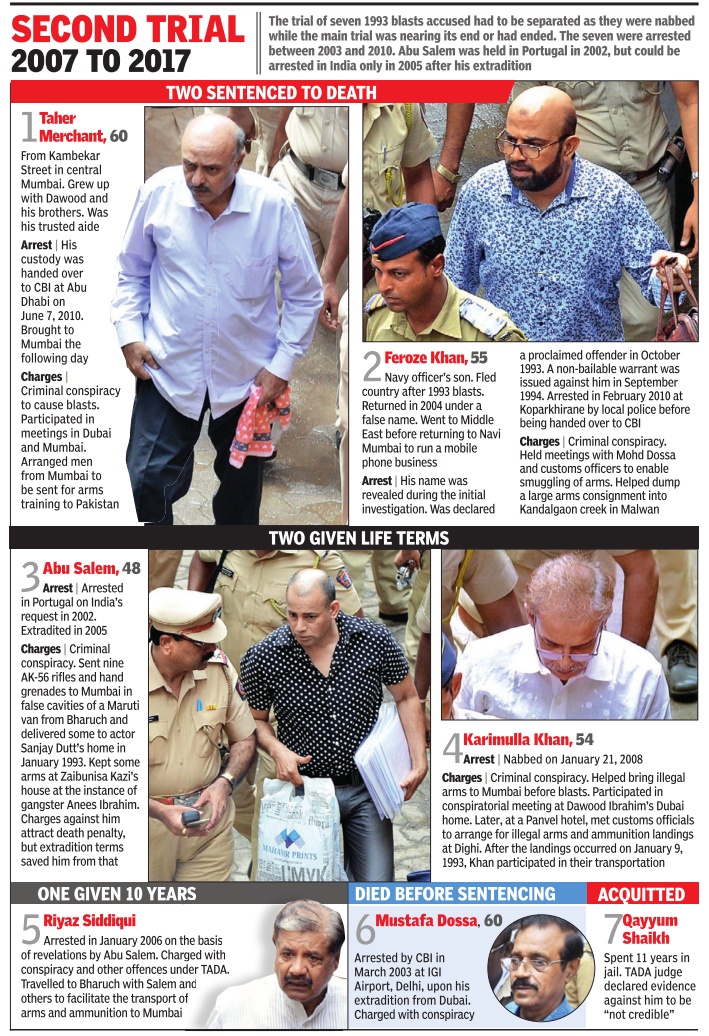
[edit] 2017: the court’s verdict
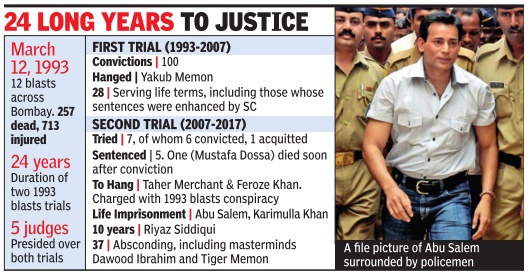
Trial Over, But Big Guns Still Absconding
Almost a quarter of a century and an execution (of Yakub Memon in 2015) later, it is the noose again, for two convicted in the March 12, 1993 Mumbai serial blasts case. A special judge presiding over the second trial in the case on Thursday pronounced death by hanging for Taher Merchant (55) and Feroz Khan (47), both of whom were absconding till 2010, for having conspired to cause the RDX blasts that killed 257 and injured 713 people. The court sentenced five of the seven accused on trial (one was acquitted in June and one died after conviction).
Extradited gangster Abu Salem (48) and Karimullah Khan (55) were spared the noose -Salem by virtue of a Lisbon court order saying he could not be given death and Khan by Tada court judge G A Sanap. Riyaz Siddiqui (67), guilty of the lesser charge of abetment, was handed a 10-year sentence. He has already been in jail for 11 years since his arrest in 2006.
This is the second and last set of accused to be convicted in the case for now. Another 37 accused are absconding, including Dawood Ibrahim. A special judge sentenced two convicts to death by hanging in the 1993 Mumbai blasts case while sparing Abu Salem the noose on Thursday . The blasts, which turned a Friday afternoon into a tragic weekend, had targeted prominent landmarks including the Air India building and Bombay Stock Exchange. The bombs were assembled in the garage at prime absconding accused Tiger Memon's Mahim house and packed into cars and scooters, which were then parked at various spots by planters. The Supreme Court in 2013 commuted the death sentence given to 10 of the planters, calling them “bows“ and the blast conspirators “the archers.“
The Tada court, which began pronouncing the sentence a little past 12.30pm, first called out Karimullah Khan. His relief was palpable when he heard “life imprisonment“ and afine of a few lakhs. Salem was next and then Siddiqui. The two big punishments were pronounced last.CBI special counsel Deepak Salvi had sought death for four, including Karimullah Khan and Mustafa Dossa, brother of prime absconding accused Mohammed Dossa, held guilty of plotting the blasts. But Dossa died in custody on June 28 before the sentencing and the trial against him stood abated.
At 1.01pm, pronouncing the first of two death sentences, the court said Merchant was to be “hanged by the neck until dead.“ The court then read out a similar sentence against Feroz. While Merchant remained stoic, repeatedly wiping the sweat off his face, a visibly shocked Feroz sat down. The court said the duo were not to be hanged until the SC confirmed the sentences.
On the accused's knowledge of their crime, the judgment said, “RDX cannot be used as a powder to kill mosquitoes and flies, and it cannot be assumed that AK-56 rifles were being distributed in schools in Bombay as toys.The accused had knowledge about the offence.“ The 11loudly whirring fans in the courtroom were switched off before the pronouncement began to enable the lawyers, the media, CBI officers and the five convicts at the back to clearly hear the judge as he held their fate a sentence away.
All five were also fined. But the court observed that since the fine amount was meagre and not adequate compensation for families of victims and the seriously injured, the District Legal Services Authority (DLSA) must recommend adequate compensation to be paid by the state to victims. The court directed the SP , CBI, to cooperate with DLSA.
After the judge left the courtroom, Feroz and Karimullah scrambled to meet their law yers present in the courtroom.Salem's lawyers went to him, at the back. As cops resisted their attempts, Feroz said, “Pareshaan mat karo. Sirf lawyer se milna hain.“ Their family members were not allowed in the courtroom but had to wait at the end of the corridor.
While Merchant's sister broke down, Qayyum Shaikh (60), the sole accused to be acquitted, arrived in court at 3pm and was seen consoling the accused. Although Siddiqui's sentence will be set off against time spent in jail, he will continue to remain behind bars as his sentence in builder Pradeep Jain's murder case is awaited.
On June 16, the court had convicted Salem, Merchant, Feroz and Karimullah on charges of criminal conspiracy, murder and acts of terrorism. Siddiqui was found guilty on the charge for abetting and aiding terrorism. Over two months, the court heard submissions on sentencing from CBI and defence advocates in cluding Sudeep Pasbola for Salem and Merchant, Wahab Khan for Feroz and Farhana Shah for Karimullah and Siddiqui. Karimullah's role was that he was present for the Shekhadi arms and RDX landing in February 1993 and had asked a co-accused to go to Pakistan for training.
Siddiqui had gone in an empty vehicle to Bharuch, where arms were to be collected, but had not collected the arms (Salem later collected them). Merchant was con cerned with sending men for arms and explosives training to Pakistan and attending conspiracy meetings in Dubai, while Feroz was involved in the Dighi arms landing in January 1993 and in conspiracy meetings in Dubai and arms transportation. The conspiracy charge against Salem could have attracted the maximum punishment but for the Portugal court order. Salem has also argued he cannot be jailed for more than 25 years, as assured by the Indian government.
[edit] Yakub Memon
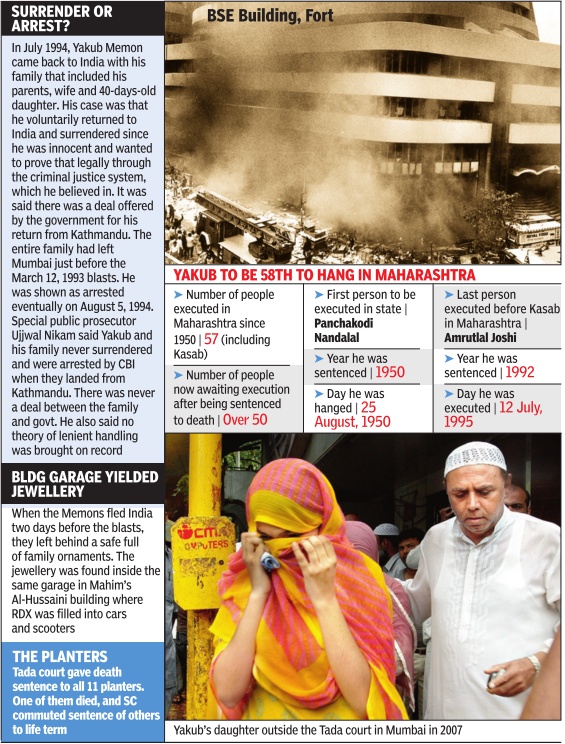
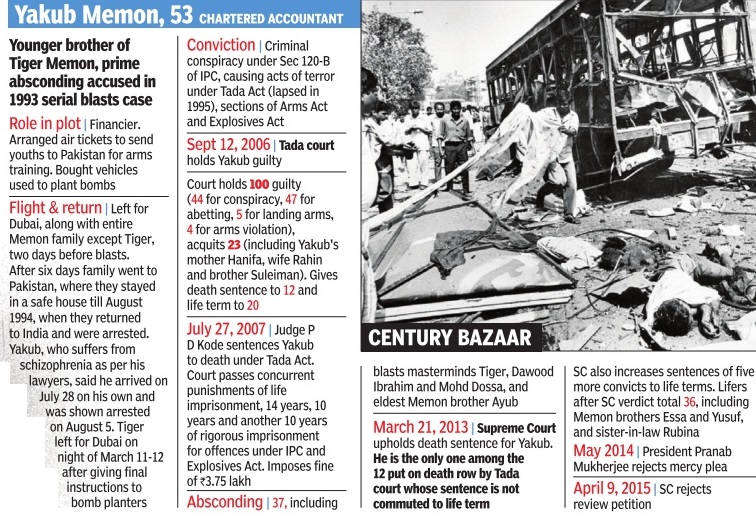
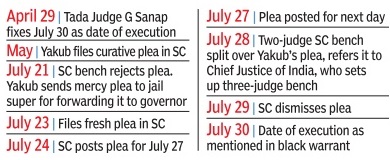
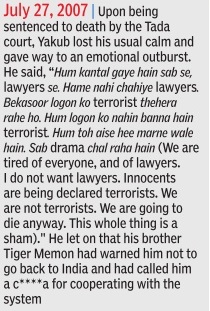
[edit] Early life
The Times of India, Jul 23 2015
Mateen Hafeez
Tiger plotted blasts to avenge loss of property
Tiger Memon, who shook Mumbai by conspiring and executing 12 deadly bomb blasts in the city on March 12, 1993, had been a man of revenge since his childhood. The blasts, which the CBI claimed in its chargesheet were to avenge demolition of Babri Masjid, also had an element of Tiger's revenge for the loss of his properties; these were set on fire during the communal riots of 1992-93. Mushtaq Abdul Razzak Nadim Memon, known as Tiger Memon, was born to middle-class parents in south Mumbai's Mohammed Ali Road on November 24, 1960. His father, Razzak, was an avid sportsman who played cricket in the Mumbai League. Razzak was originally known as Tiger after the famed Indian skipper. Later, Memon inherited his father's moniker, with an added `Junior', due to his habit of growling while talking and arguing. “He was vengeful since childhood. Once while playing cricket during his school days. Tiger got injured on the wicket. He was bleeding profusely , but instead of seeking treatment, he insisted on continuing to play and hit the ball. At the end of the match, Tiger had scored a century,“ said S Hussain Zaidi, author of Black Friday ,a book on the blasts.
Yakub may not live to receive degree
Death row prisoner Yakub Memon may not live to receive his MA political science degree from the Indira Gandhi National Open University (IGNOU). The convocation ceremony for it is slated for August 8 while he is likely to be executed on July 30 for his role in the 1993 Mumbai blasts.This is the second degree he pursued as an inmate at the Nagpur Central Jail. The chartered accountant had earlier completed MA in English Literature in 2012 scoring 58% marks. He enrolled for MA Political Science the same year and cleared it in December last year scoring 56% marks.“The degree certificate will be sent from the New Delhi office just before the convocation ceremony,“ said IGNOU regional director P Sivaswaroop.
[edit] The only convict on death row
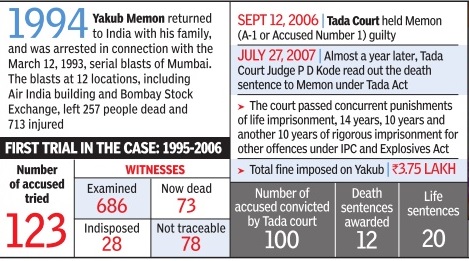
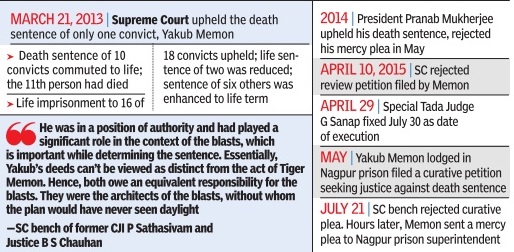
The Times of India, Jul 22 2015
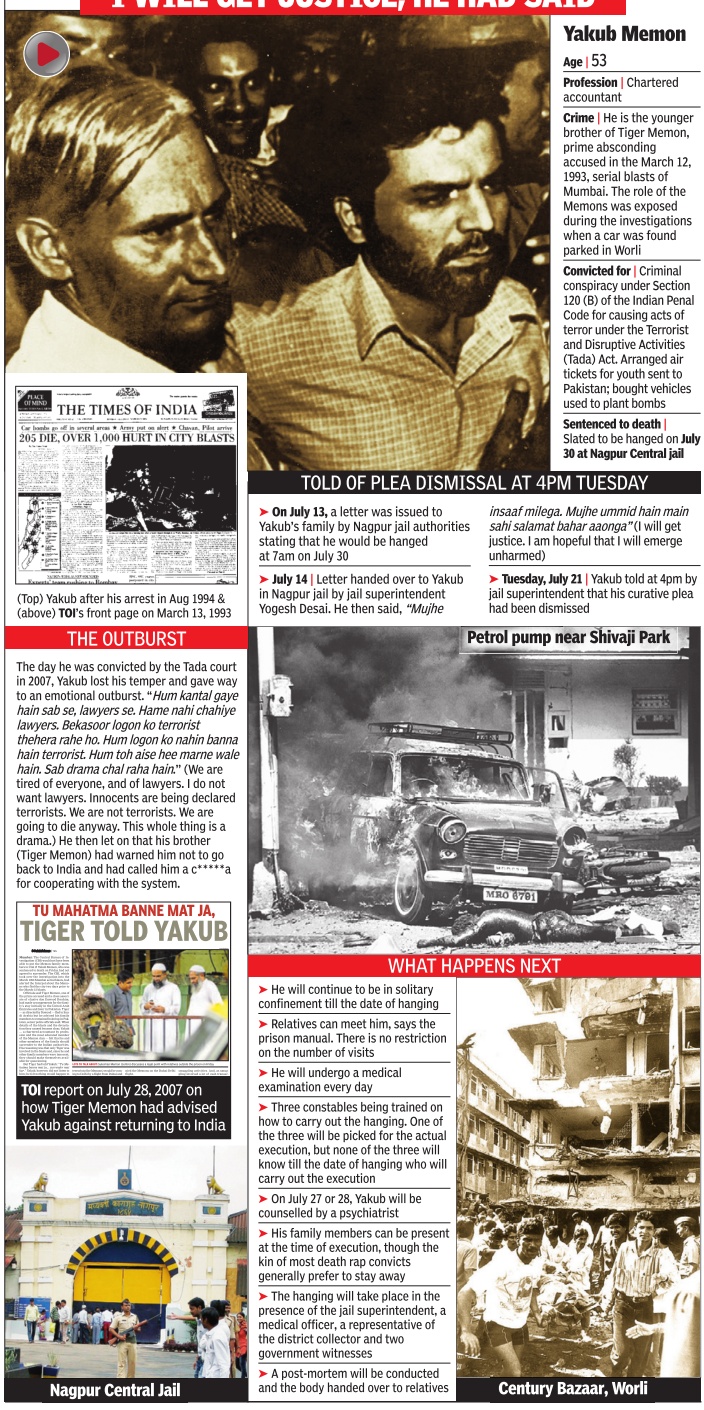
Dhananjay Mahapatra
He wasn't among those who carried arms, but he stood behind them: SC
Tiger Memon's conspiracy , with the help of Dawood Ibrahim, to avenge Babri Masjid demolition at Ayodhya through serial bomb blasts in Mumbai, will now cost him the life of his cub brother Yakub. Mustaq aka Tiger Memon, the alleged mastermind of the 1993 serial blasts, stayed in the trial court records along with Dawood as AA or `absconding accused'. Yakub, who handled details to give concrete shape to the conspiracy and tie the loose ends, was named Accused Number 1 in trial records.
Trial Judge P D Kode had examined in detail the evidence for 13 years before awarding a death sentence to Yakub Memon (A-1) and ten others.
Their sentences were subject to confirmation by Supreme Court. A bench of Justices P Sathasivam and B S Chauhan examined the evidence afresh, given the case's sensitive nature and the large number of death penalties awarded.
The final judgment came on March 21, 2013, almost a year later. Only Yakub's death penalty was confirmed.
Of the 792-page judgment, nearly 300 pages were devoted to examining evidence against Yakub (A-1). Writing the judgment for the bench, Justice Sathsaivam said: “From the total appreciation of the evidence as produced by the prosecution in support of the case against A-1, an offence of conspiracy is clearly made out. The evidence in respect of A-1 is in the nature of confessions made by the co-accused persons, the testimonies of the prosecution witnesses and documentary evidence on record and recoveries.“ The SC said: “The prosecution has also proved recoveries of incriminating articles like hand grenades etc, and also for the purchase of air tickets, getting passports and visas for the persons who went to Pakistan via Dubai for training in handling of arms and ammunitions.“
The court noted Yakub's involvement in handling finances for the blasts. “ Apart from this, there are ample evidence to show that he was in-charge of all money transactions and monitoring the activities of all the persons concerned in the movement.
“The prosecution has also established that A-1 owned a blue Maruti car which was used for carrying explosives and detonators one day before the blasts took place on March 12, 1993. A-1 left for Dubai on March 11, 1993 with the Indian passport and thereafter he entered Pakistan with Pakistani passport.
“Though he was not one among the persons who carried arms and ammunitions used for the blast but it was he who stood behind them from starting till the end, viz conspiracy , planning and making all the arrangements for sending certain persons to Pakistan for training in handling of arms and ammunitions.
“A perusal of the above confessions by the co-conspirators would show that the appellant (A-1) was playing a key role in furtherance of the above said conspiracy . The above evidence along with further material relied on by the prosecution show that A-1 also played an active role in generation and management of funds for achieving the object behind the conspiracy and in all subsequent events,“ the apex court had said on March 21, 2013.
Yakub's counsel Jaspal Singh had argued that the approvers' confession nor that of any other co-accused or any independent witness show that Yakub knew or participated in any conspiracy meeting.
The SC said, “The fact that he was constantly present at Al Hussain building, where the major part of the plans have been made and executed, is established. And his active involvement has also emerged from the evidence on record as to how he was dealing with the so-called men of Tiger...The accused need not be present at each and every meeting for being held to be a part of the conspiracy . (With inputs by Swati Deshpande)
[edit] Is the death penalty justified on Indian part?
The Times of India, Jul 25 2015
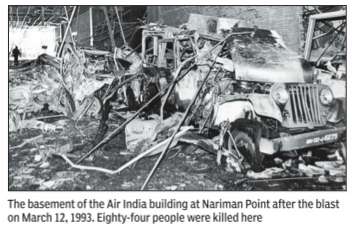
`We promised Yakub he won't hang'
`He wouldn't have surrendered, handed over evidence of ISI hand otherwise'
An article written by former RAW officer and prominent strategic affairs expert opposing Mumbai blasts accused Yakub Memon's capital punishment is finding support among other intelligence officers, both former as well as serving. The late B Raman, who played a key role in bringing Memon back from Pakistan, did not dispute that there was not “an iota of doubt about the involvement of Yakub and other members of the family in the conspiracy and their cooperation with the ISI till July 1994“. He also said: “In normal circumstances, Yakub would have deserved the death penalty if one only took into consideration his conduct and role before July 1994.“
However, he made a strong pitch for leniency. Raman, who passed away in 2013, wrote in 2007, just days after the court handed out death penalty to Memon: “If one also takes into consideration his conduct and role af ter he was informally picked up in Kathmandu, there is a strong case for having second thoughts about the suitability of the death penalty .“ Raman's essay was made public by Rediff.com.
Raman retired from RAW on August 31, 1994, just days after he played a critical role in ensuring the younger Memon left Pakistan to land in Kathmandu. Yakub, whose elder brother Tiger Memon and Dawood Ibrahim were the key conspirators of 1993 Bombay blasts in which 257 people were killed, had got tired of leading a life in the captivity of ISI and wanted to return to India in exchange for an ironclad guarantee that he would not be handed the death sentence if he helped Indian agencies nail Pakistan's role in the blasts, months after the Babri Masjid demolition on December 6, 1992.
Once in Indian custody , he handed to Indian investigators a huge cache of documents, videos, photographs, passports etc that proved the role played by Pakistan's ISI . “He (Yakub) definitely had an assurance from us, and that is why he came to Kathmandu, handed over so much data to us. We have betrayed him,“ a former RAW official said. He said Memon actively cooperated with Indian agencies, persuaded many of his family members to leave Pakistan, provided critical intelligence and trusted Indian courts. “There is something not right about what is playing out,“ the official, who also played a role in Memon's return, said.
“...Some mitigating circumstances in the case of Yakub and some other members of the family were probably not brought to the notice of the court by the prosecution... In their eagerness to obtain the death penalty , the fact that there were mitigating circumstances do (sic) not appear to have been highlighted,“ Raman said.
Another RAW officer, who too had direct knowledge of the entire operation, said Memon's landing in Kathmandu, him drawing attention of security forces at the airport to get arrested, a suitcase full of intelligence about Pakistan's involvement, in the 1993 blast were all part of “one of our finest operations.“ And Memon would not have done it all “without some kind of assurance, isn't it?“ he said, without elaborating on what the understanding was.
Raman said, “In July 1994, Yakub was informally picked up in Kathmandu, with the help of the Nepal police, driven across Nepal to a town in Indian territory , flown to Delhi by an aircraft of the Aviation Research Centre and formally arrested in Old Delhi and taken into custody... The entire operation was coordinated by me.“ Some other retired and serving intelligence officers too shared the same arguments.They said there was no doubt about Yakub's involvement.“He may not have planted a bomb, but he actively aided Tiger. However, what needs to be taken into consideration is his decision to return to India, and help with investigations,“ a serving officer said.
[edit] SC's reasons for hanging Yakub Memon
The Times of India, Jul 30 2015
Swati Deshpande
SC explains why Yakub, not bomb planters, received death
The SC, while confirming the death sentence of Yakub Memon and calling him a key conspirator, held that the ten others who were on death row, apart from the twelfth who was also sent to the gallows by the trial court and had died pending appeal, were only the bows which the archer controlled and hence their sentences were commuted to life. The SC held that the mitigating factors advanced by Yakub's counsel Jaspal Singh that he had “returned to India unlike other absconders, had no criminal antecedents, suffered from depression since 1996 and had already served 19 years in jail“ as not being strong enough to “bargain for reduction of sentence“. But when it came to the planters of the bombs, the SC held that the mitigating factors their lawyer Farhana Shah had pointed out did make a point for commuting the harsh death sentence to life terms.
Shah had said most planters had expressed remorse, were poor, didn't have criminal antecedents, many were young when the blasts occurred and they cooperated with the investigation.
The SC said, “all the 10 appellants belong to the lower strata of society , most of whom don't even have any regular job for their livelihood. In brief, their personal life was relatively moderate before this incident. Subsequently , these appellants have fallen prey to the ulterior motive of the conspirators for accomplishing their hidden motives, which was to spread terror among the people. Such proof can in no way exonerate or excuse them for their participation in the commission of crime. However, it provides a somewhat nuanced picture and may imply that their participation in the massacres resulted from misguided notions rather than extremism.
[edit] Zaibunissa Kazi and Abu Salem
[edit] Zaibunissa Kazi's 'innocent widow' act
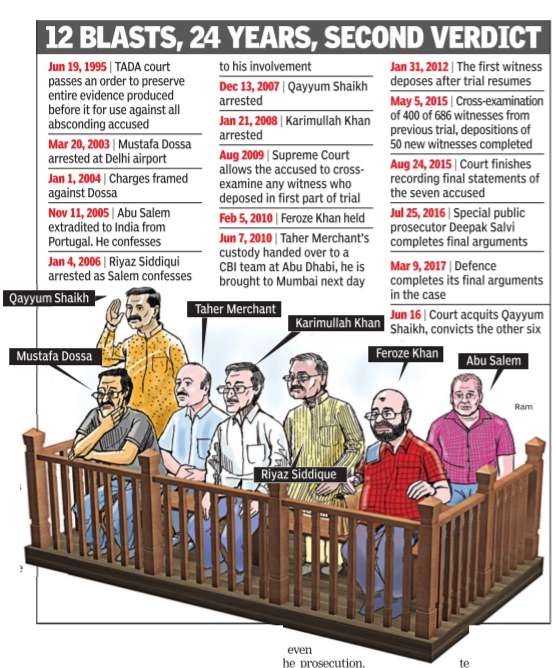
CBI Will Seek Death For Four, Salem's Case A Grey Zone
Six accused were pronounced guilty on Friday by a special court in the 1993 serial blasts case that claimed 257 lives in the city. Qayyum Shaikh, 64, behind bars for almost 11 years, was acquitted for lack of evidence.
Special judge Govind A Sanap found “concrete evidence“ against gangsters Abu Salem, 48, Mustafa Dossa, 60, Taher Merchant, 55, Feroze Khan, 47, and Karimullah Khan, 55, and convicted them during the hour-long procedure on charges of criminal conspiracy , murder and indulging in acts of terrorism that cause death. Riyaz Siddiqui, 67, was found guilty of abetting and aiding terrorism, a charge that attracts a maximum punishment of life imprisonment. Arguments by the prosecution on the quantum of sentence are likely to begin in the special Terrorist and Disruptive Activities (Prevention) Act court.
“The CBI will seek the death sentence against four accused (Dossa, Merchant, Feroze and Khan). In light of the undertaking given to Portugal at the time of Salem's extradition, we will have to examine the options regarding his sentencing,“ said CBI special counsel Deepak Salvi.The undertaking says Salem cannot be booked under charges that attract a sentence of more than 25 years.
This trial of the seven is the second in the 1993 case. The main trial of 123 accused ended in 2006 with the conviction of 100.Yakub Memon, brother of absconding prime accused Tiger Memon, was hanged in 2015, and the others have served or are serving their sentences.
The court said none of the accused was held guilty under the IPC charge of waging war against the nation. When the court said evidence against Qayyum Shaikh, 64, accused of bringing smuggled arms to the city with Salem, “is not credible and acceptable“ and acquitted him, he raised his folded arms and thanked the court. Shaikh was sitting alongside the others in the dock amid high security . Dossa chatted with those around. Salem kept to himself. Merchant, Siddi qui and Khan kept reciting prayers through the proceedings that began at 12.20 pm.
The judge first pronounced the conviction against Dossa and said the prosecution has proved that after the Babri Masjid demolition and the subsequent riots, Dossa joined the first conspiracy meeting in Dubai in December 1992 with “other prime absconding“ accused Md Dossa, Tiger Memon and Dawood Ibrahim.
“The accused deliberately and consciously participated in the meeting which gave birth to the original design of the criminal conspiracy to take revenge against the government and the Hindus.The accused was the member of the core group of conspirators,“ the judge said. Dossa could not hear the words properly and had to ask others about the verdict. When told the conspiracy charges were proved against him, Dossa appeared crestfallen.
Calling Feroze one of the main conspirators, the court said he possessed “complete and crystal clear knowledge“ being a close confidant of the Dossa brothers. It held that Feroze was “privy to the object of the conspiracy hatched, its aim and hence performed the same with vigour and determination“.
Though not alleged to have been present in any of the 15 conspiracy meetings, Salem was dubbed as one of the main conspirators for “acting in consonance with the object of the conspiracy hatched“ by absconding ac cused Anees Ibrahim and Dossa. The court said that given his close proximity to them, he took it upon himself to bring some part of the arms and ammunitions smuggled into India through the landing on Dighi Jetty on January 9, 1993.
The court spoke extensively about Merchant's “prominent role“ and “indulgence in the conspiracy (that) must be held directly responsible for the bomb explosions“. Khan participated in conspiracy meetings and sent an accused for weapons training in Pakistan.
After the proceedings ended at 1.20 pm, the court allowed the accused to meet their family members. Cops restricted access and allowed only two family members to meet each of them. Salem did not have many visitors. His family members remained confined in their home in Azamgarh, UP.
[edit] “Zaibunnisa Kazi alarmed Salem to run”: Police
She Walked Out Of Police Stn, Called His Aide: Ex-Cop
In a rare expression of regret, top cop Rakesh Maria said if he had been firmer with accused Zaibunnisa Kazi, Abu Salem would not have slipped through his fingers and graduated into a big gangster ordering `hits' from another country .
Soon after the serial blasts in 1993, then commissioner of police Amarjit Samra asked Maria, posted as DCP (traffic), to join the investigation. He led the probe with aplomb and it marked a turning point in his career.
But the former Mumbai police commissioner still rues one moment in the probe. “I regret having trusted Zaibunissa. Had Zaibunissa not leaked the information (cops looking for Salem), Salem would have been behind bars long ago. The history of the underworld would have changed and the extortion racket would not have taken such a toll on businessmen and celebrities in Mumbai,“ said Maria, while expressing satisfaction with Friday's conviction. Probing the arms trail from Bharuch, especially the AK-56 rifles, after the blasts, Maria's team learnt Salem had stored the weapons in Zaibunissa Kazi's house near Mount Mary in Bandra. “Our team brought in Zaibunissa for questioning. She cried and said she was a widow and had nothing to do with the arms.So we let her go,“ said Maria.
During interrogation a couple of hours later of other accused, they again pointed at Zaibunissa. A police team brought her to Mahim police station, where Maria was monitoring the investigation. “When we grilled her, she broke down and said Salem and his friend Aziz Bilakhia her. As she confessed, I let Zaibunissa go. I simultaneously sent a team to pick up Salem and Bilakhia from Arsa Market in Andheri, where they used to sell smuggled goods. My team did not find them. Later I found out that Zaibunissa had rushed to a PCO booth outside Mahim police station, called up Bilakhia and told them to flee as the police would be there anytime,“ said Maria.
Bilakhia fled to Dubai, Salem took shelter in Lucknow even as police hunted for him in his native place of Azamgarh in UP . Later, Salem also escaped to Dubai and joined Dawood Ibrahim. Manisha Koirala's manager Ajit Deewani, builder Pradeep Jain and film music mogul Gulshan Kumar were among those killed on Salem's orders.
“The special court convicted the main plotters and again endorsed our investigations. I feel with this it kind of evidence, it would not be difficult to convict even big fish such as Dawood Ibrahim, Anees Ibrahim, Tiger Memon and Mohammed Dossa,“ said Maria, complimenting the Mumbai police team that cracked the case, especially Dinesh Kadam, Sukhlal Varpe, Nadgowda, Bhaskar Dhangle and Dhananjay Daund.